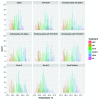Comparison of Aqueous and Alcohol-based Agents for Presurgical Skin Preparation Methods in Mice
- PMID: 29970215
- PMCID: PMC6059221
- DOI: 10.30802/AALAS-JAALAS-17-000128
Comparison of Aqueous and Alcohol-based Agents for Presurgical Skin Preparation Methods in Mice
Abstract
Preparing the skin of rodents for surgery often involves multiple applications of antiseptic agents. However, fewer applications may achieve the same antiseptic outcome. We evaluated the antimicrobial efficacy and effects on intraoperative body temperature of various surgical scrub agents, including novel waterless alcohol-based (WAB) options. Prior to ventral laparotomy, female C57BL/6 mice were treated with 0.9% saline (control); 70% ethanol; 10% povidone-iodine alternated with saline or 70% ethanol; 2% chlorhexidine digluconate alternated with saline or 70% ethanol; or 1 of 3 WAB products-commercial surgical scrub A, commercial surgical scrub B, or a common commercial hand sanitizer. Core temperatures were recorded, and aerobic culture swabs were collected from the surgical site at multiple time points. Intraoperative temperature trajectories for animals treated with scrub B, 10% povidone-iodine with saline, or hand sanitizer did not differ from saline (control). Temperature trajectories of mice treated with other scrub agents did differ significantly from saline. Bacteria were not detected at the operative site after 3 scrubs of 70% ethanol or 10% povidone-iodine alternated with ethanol, 2 scrubs of scrub A or B, 1 scrub of hand sanitizer, and both 1 and 3 scrubs of 2% chlorhexidine alternated with ethanol. Scrub B and 2% chlorhexidine-ethanol demonstrated prolonged antibacterial efficacy. Histology of corresponding haired skin sections revealed no differences in postoperative healing between groups, and no postoperative infections occurred. These results indicate that various novel WAB disinfectants, particularly scrub B (61% ethanol and 1% chlorhexidine gluconate), mitigate intraoperative temperature effects associated with several traditional agents and combinations. Furthermore, reduction of skin bacterial load without adverse effects on healing was seen with fewer than triplicate applications of most tested agents. Ultimately effective skin preparation can be achieved by using only 1 or 2 applications of scrub, thus rendering the triplicate skin-prep method unnecessary in laboratory mice.
Figures



Similar articles
-
The Use of Waterless Alcohol-based Antiseptic for Surgical Skin Preparation in Rhesus Macaques (Macaca mulatta).J Am Assoc Lab Anim Sci. 2022 Nov 1;61(6):678-682. doi: 10.30802/AALAS-JAALAS-22-000054. Epub 2022 Nov 15. J Am Assoc Lab Anim Sci. 2022. PMID: 36379475 Free PMC article.
-
Antiseptic efficacies of waterless hand rub, chlorhexidine scrub, and povidone-iodine scrub in surgical settings: a meta-analysis of randomized controlled trials.J Hosp Infect. 2019 Apr;101(4):370-379. doi: 10.1016/j.jhin.2018.11.012. Epub 2018 Nov 28. J Hosp Infect. 2019. PMID: 30500384
-
Evaluation of 4 Presurgical Skin Preparation Methods in Mice.J Am Assoc Lab Anim Sci. 2019 Jan 1;58(1):71-77. doi: 10.30802/AALAS-JAALAS-18-000047. Epub 2019 Jan 4. J Am Assoc Lab Anim Sci. 2019. PMID: 30609948 Free PMC article.
-
An evaluation of five protocols for surgical handwashing in relation to skin condition and microbial counts.J Hosp Infect. 1997 May;36(1):49-65. doi: 10.1016/s0195-6701(97)90090-6. J Hosp Infect. 1997. PMID: 9172045 Clinical Trial.
-
Should surgeons scrub with chlorhexidine or iodine prior to surgery?Interact Cardiovasc Thorac Surg. 2011 Jun;12(6):1017-21. doi: 10.1510/icvts.2010.259796. Epub 2011 Mar 1. Interact Cardiovasc Thorac Surg. 2011. PMID: 21362729 Review.
Cited by
-
The Effect of Different Preoperative Depilation Ways on the Healing of Wounded Skin in Mice.Animals (Basel). 2022 Feb 25;12(5):581. doi: 10.3390/ani12050581. Animals (Basel). 2022. PMID: 35268149 Free PMC article.
-
Using Waterless Alcohol-based Antiseptic for Skin Preparation and Active Thermal Support in Laboratory Rats.J Am Assoc Lab Anim Sci. 2021 May 1;60(3):365-373. doi: 10.30802/AALAS-JAALAS-20-000128. Epub 2021 May 4. J Am Assoc Lab Anim Sci. 2021. PMID: 33952387 Free PMC article.
-
Evaluation of Active Warming and Surgical Draping for Perioperative Thermal Support in Laboratory Mice.J Am Assoc Lab Anim Sci. 2022 Sep 1;61(5):482-494. doi: 10.30802/AALAS-JAALAS-21-000036. Epub 2022 Aug 31. J Am Assoc Lab Anim Sci. 2022. PMID: 36045004 Free PMC article.
-
Preoperative skin asepsis protocols using chlorhexidine versus povidone-iodine in veterinary surgery: A systematic review and meta-analysis.Vet Surg. 2022 Jul;51(5):744-752. doi: 10.1111/vsu.13810. Epub 2022 Apr 18. Vet Surg. 2022. PMID: 35437786 Free PMC article.
-
The Use of Waterless Alcohol-based Antiseptic for Surgical Skin Preparation in Rhesus Macaques (Macaca mulatta).J Am Assoc Lab Anim Sci. 2022 Nov 1;61(6):678-682. doi: 10.30802/AALAS-JAALAS-22-000054. Epub 2022 Nov 15. J Am Assoc Lab Anim Sci. 2022. PMID: 36379475 Free PMC article.
References
Publication types
MeSH terms
Substances
LinkOut - more resources
Full Text Sources
Other Literature Sources
Miscellaneous

